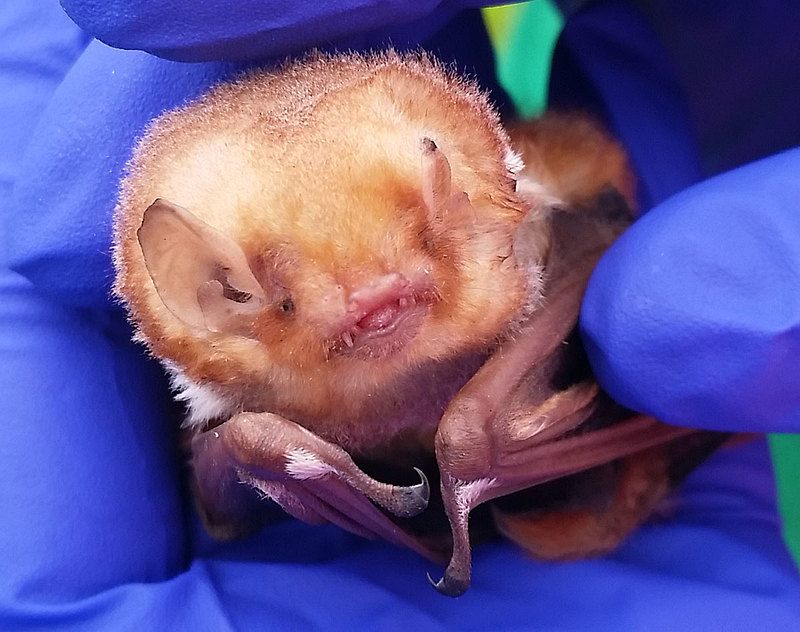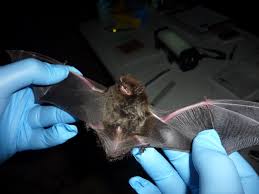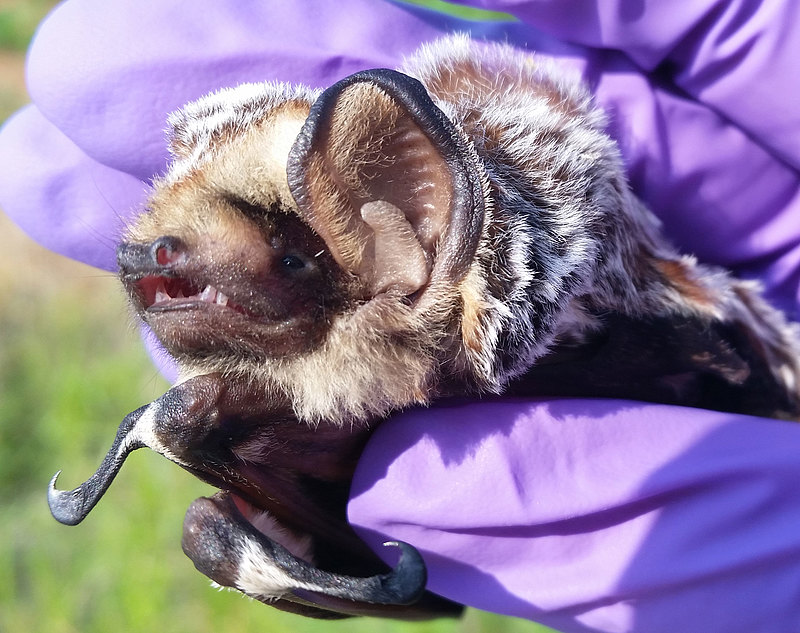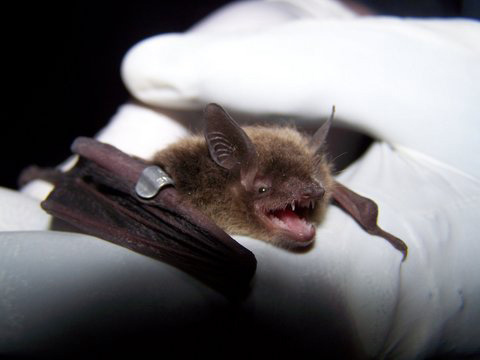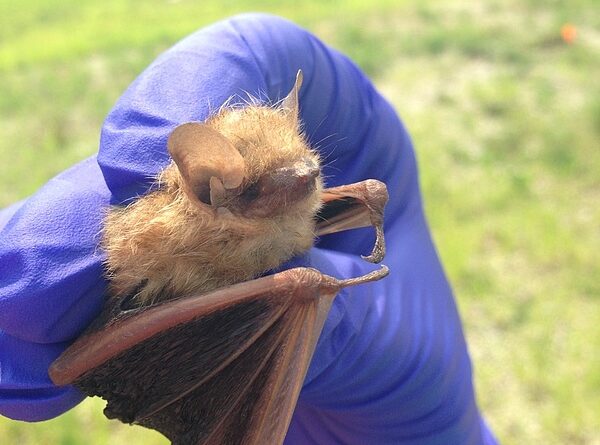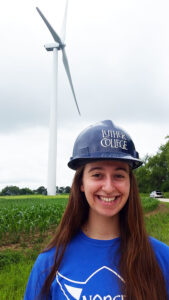Reasons to Study Bats
Bats are an important part of our environment and provide us with many benefits, including insect control and fertilizer. However, bat populations in the United States are being threatened by the spread of the fungal disease known as white-nose syndrome (WNS) and the rapid growth of wind energy development.
Bats are susceptible to wind turbine fatalities for reasons we don’t fully understand yet. Although we are aware of bat fatalities at wind facilities, it is difficult to know how these fatalities are affecting our environment without a better knowledge of basic bat ecology, which is sparse in many areas including northeast Iowa. Relatively little is known about species distribution and density, migration timing and pattern, and feeding, roosting, and mating behavior. Also, most of what we understand about turbine impacts comes from studies conducted at large-scale, multi-turbine wind farms. Virtually no studies have examined the impacts of single-turbine facilities, such as the one at Luther College.
Bat Facts
There are 7 potential bat species in Decorah. Take a closer look at who’s flying around town:
The goal of our study is to examine bat activity and fatality at the Luther College wind turbine in Decorah, IA, an area that has not yet been affected by white-nose syndrome but is at the edge of the infection zone. Student researchers are searching the turbine daily for bat carcasses from June 15-October 15, 2015. Additionally, we have set up bat acoustic recording devices at the turbine and nearby areas to track the bat activity at these locations. We have started a community-based volunteer program to collect additional data on bat activity around the Decorah area.
A pilot study conducted at the Luther wind turbine last year suggested some surprising patterns. First, we found 27 bat carcasses underneath the turbine throughout the summer, which is higher than values reported per turbine at wind farms in the Midwest. Second, we found a surprising diversity of species represented among the carcasses. Whereas studies often report that only a couple of species are most at risk (those that are migratory and roost in trees), we found 6 different species among the fatalities, and the resident cave-dwelling species were slightly more common. Finally, by recording the ultrasonic sounds that bats use to navigate and track their insect prey, we found that bat activity (i.e., highest number of recording calls) peaked in late July, but fatality events occurred intermittently throughout the entire study period. This contrasts to most other studies, where fatalities show a pronounced peak in late summer/early fall coinciding with the peak in total bat activity.
This project began as a response to one question-what does our local bat population look like? We wanted to know what kind of bats we have in the Decorah area, their numbers and their approximate location.
We love this project because it puts the knowledge and resources into the hands of our community members allowing them to lend a helping hand in local research and bat conservation. Our volunteers use our specially designed “bat packs” to walk or bike their favorite Decorah area trails and record bat calls that can’t be heard by our ears. Bat calls are run through software that allows our volunteers to visualize the bat call. These calls help us identify species in the area and potential locations of bat roosts.
Along with these walks we also give community presentations throughout the summer talking about threats to our bat populations and what can be done to help.
Please email your questions to the bat project team at batproject@luther.edu.
Volunteer Trails
Use the interactive map to view the different volunteer trails set up around the Decorah area.
Note: The Fish Hatchery trail is not currently available. We apologize and hope to bring it back to our pool of trails soon.
Summer 2015 Trails
The summer of 2015 was our first summer establishing our community project. Not only did we get great insight into our local bat species and their whereabouts, we had fun sharing and connecting with local people interested in bat conservation.
Trails included: Decorah High School Trail, Fish Hatchery Trail, Ice Caves Trail, Luther Loop, Phelps Park Trail, Pole Line Road Trail, Pulpit Rock Trail, Custom Trails.
As a community we know very little about our local bat populations. Along with the research being done about the wind turbine’s effects on these populations, research is being done to better understand these populations. Bat populations are difficult to study and observe. The Decorah Bat Roost Project hopes to gain insight into the location and roosting patterns of the Decorah bats.
A bat roost is the location bats return to in the morning to sleep throughout the day. Different species and gender of bats have varying roosting patterns. The scientific community has a lot to learn about these nocturnal creatures. With the data collected through this project we have the capability to learn about population size and location, roosting bat habits and so much more.
If you know of a bat roost please click the link below to report.
Check out these resources for more information about bats.
General Information
White Nose Syndrome
- Battle for the Bats (video)
- Battle for the Bats Brochure
- Map of white-nose syndrome occurrences in the US
Rabies
How to Build a Bat House
Dawn Reding
Associate Professor of Biology
Education: Ph.D., Ecology and Evolutionary Biology, Iowa State University; M.S., Zoology, University of Hawaii; B.S., Environmental Science, University of Dubuque
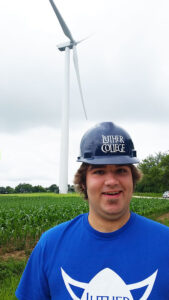
Nathan Hemming ’18
Alumni
Biology, Secondary Education (minor)
My goal in the future is to continue studying science education and hopefully become a high school science teacher. Along with that, I participate in choir at Luther. I enjoy outdoor activities like canoeing and disc sports.
Marcella Meza ’18
Alumni
Biology, Philosophy (minor)
I am very excited to be a student researcher in the Biology department this year, and in the future I’d also like to continue researching something in the field of Biology. I also participate in choir at Luther, and enjoy all kinds of outdoor activities.
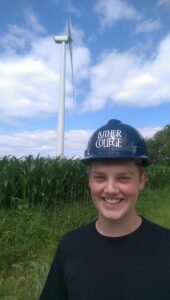
Kieran Okerstrom ’18
Alumni
Biology, Computer Science, Math
I’m interested in the emerging field of bioinformatics, and hope to someday do research combining biology, mathematics and computer science. In my spare time, I like to learn new languages and volunteer at the animal shelter.
